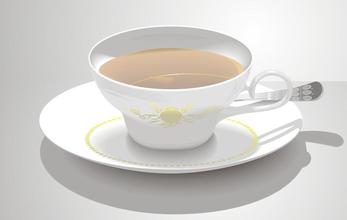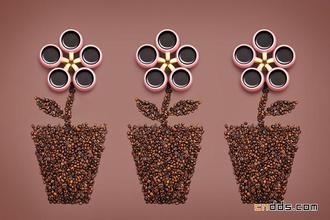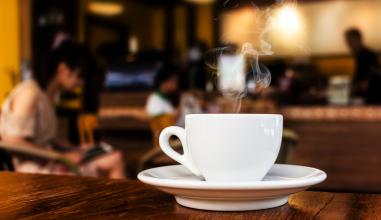How many ways are there to make coffee?
Drip filter coffee was originally invented by the Germans. Supermarkets sell Melita coffee pot filter paper, which is the brand founded by the Germans at that time. The practice of dripping filter coffee is simply to grind the coffee into powder, put it in a funnel with a layer of filter paper, and then pour hot water on it. Due to the gravity of the earth, the coffee will flow out at the bottom (so if it is in space, without gravity, you can't do this). The same is true of hand brewing.
Hand-made coffee usually uses lightly roasted coffee beans, the grinding particles are relatively thick, about 8 to 12 grams of coffee powder, can do about a cup of 120ml, can not use boiling water, to use 85 to 95 °C hot water to make.
Hand-brewed coffee will have different tastes according to different methods, some people will pour it on the coffee powder in a circle, and some people will first pour the coffee powder from the center to the outer ring, no matter which way, make sure the coffee powder can be evenly moistened. Therefore, whether a cup of hand-made coffee tastes good or not depends on whether the brewer has enough experience.
Little knowledge: there is a difference between American hand flushing and Japanese hand flushing.
Although the American style and the Japanese style may use the same filter cup, there are differences in roasting and grinding of coffee beans, filter paper, water temperature and manipulation. The biggest difference is that American hand flushing requires stirring coffee powder with a stirring stick at the same time, similar to that of a siphon pot, while Japanese, Korean, Taiwan and domestic hand flushes only draw circles with water and do not need to stir coffee powder.
As a result, Japanese brewing pays more attention to purity, while American brewing pays more attention to its own flavor.
Mocha pot (Moka Maker)
The basic principle of the mocha pot is to use pressurized hot water to quickly extract coffee liquid through coffee powder. The earliest mocha pots were made by Italians, and mocha coffee pots are more popular in Europe.
The mocha pot is divided into two parts, the water is boiled in the lower part, the steam pressure is produced after boiling, and the boiling water rises, and passes through the filter pot containing coffee powder. When the coffee is left in half, turn the fire down. If the temperature is too high, it will produce scorched smell. Coffee brewed in a mocha pot will have a relatively calm and unique flavor, but it is not recommended to cook fine beans, because the mocha pot has a great influence on the flavor of the coffee.
The picture shows AM's new BATMAN-shaped mocha pot.
Mocha pots usually use medium-finely ground coffee powder.
Little knowledge: the mocha pot is also a tool used to extract espresso. It is widely used in Europe and Latin American countries and is called "Italian trickling filter pot" in the United States.
Italian coffee maker (Espresso Machine)
The principle of Italian coffee machine is to use a mixture of high-pressure steam and water to quickly pass through the coffee layer and instantly extract coffee, so that the coffee temperature is very high, the content of impurities such as caffeine is very low, and the taste is rich. The espresso machine can continuously extract several cups of coffee. In the process of extraction, the oil and gum in the coffee beans can be emulsified and melted under high pressure, and the essence of the coffee beans can be completely extracted by the pressure cup.
The picture shows the Rolls-Royce LA MARZOCCO coffee machine in the Italian coffee machine.
Nowadays, espresso is popular all over the world. People who have knowledge of coffee can name many varieties of espresso, such as mocha coffee, coffee latte, cappuccino, caramel macchiato and so on. Espresso is also called fancy coffee, because the espresso made by Italian coffee machine can make different coffee by adding milk, foam, cocoa, syrup and cream. Because of this, coffee is more and more popular.
The term espresso is known to anyone who knows coffee, so do you know why espresso is called espresso? Since serendipity mainly operates espresso, let's focus on espresso.
Espresso, Latin originally means "to be under pressure." In other words, the method of boiling coffee with hot water and pressure extraction belongs to Espresso. Espresso is not only the name of this kind of coffee, but also the name of this kind of coffee extraction method. The mocha coffee pot mentioned earlier is also known as the tool for making espresso. Of course, it was the early Italian pot. After the Italian coffee machine was invented, the mocha pot was gradually abandoned, so the mocha pot is not known to many people.
Coffee shop has become a symbol of petty bourgeoisie life. Some cafes on the market mainly produce espresso, but there are not many really excellent Italian cafes. Some cafes mainly deal in hand brewing and boutique coffee, but most of them mainly deal in light meals, desserts, fruit juices and alcoholic drinks under the banner of cafes, rather than focusing on coffee production. This is why there are fewer and fewer really good cafes. The word "coffee" comes from the Greek word "kaweh", which means "strength and enthusiasm". Drinking coffee is not only a pastime, its rich cultural connotation is a pursuit of an ideal way of life. Therefore, the word "cafe" is naturally synonymous with sentiment and taste.
The picture shows the Italian process of making macchiato, which is being extracted by espresso.
In fact, a big reason why espresso is not fully popular is that the price of espresso machines is high. From a business point of view, it takes a long time for espresso to become popular. The price of an Italian coffee machine ranges from tens of thousands to more than a hundred thousand. If it is larger, the price can go to tens of thousands of units. Of course, in addition to the basic equipment, the barista's experience and production methods are also very important.
A little knowledge
Espresso is usually tasted in small cups, preferably within three mouthfuls, without adding milk and sugar, how to make a good Italian concentrate for it?
1, first of all, a good espresso, the surface will be covered with a full-bodied, crimson Crema,Crema is also transliterated as Kramer, Kramer, Crema is the meaning of coffee oil, about it, there is a lot of knowledge, do not introduce in detail, to put it simply, a good espresso, there must be Crema; but there is Crema espresso, not necessarily good coffee.
2. After drinking good espresso, there will be a strong aroma in the cup, which is about Crema. Because its unique honeycomb structure stores a large amount of aromatic substances, when the structure disintegrates, it releases a large amount of fragrance, which is what we call coffee fragrance.
3. Observe the "hanging cup" degree of Crema. It is called good Italian concentration if there are too many hanging cups. In foreign countries, if there is no "hanging cup", you can refuse to pay the bill.
Siphon pot (Syphon)
Siphon pot, commonly known as "plug wind pot" or "siphon", is one of the most popular coffee brewing methods in cafes. Although it is called "siphon", it has nothing to do with the siphon principle, but uses water heating to produce water vapor, which causes thermal expansion and cold contraction. Push the hot water from the lower sphere to the upper pot, and then suck back the water from the upper pot after the lower pot cools.
The picture shows the process when the hot water just rises to the upper sphere.
The invention of the siphon pot was inspired by the British in the laboratory and improved by the French, but it always had the feeling of doing experiments at a glance. Many people like the precision of siphon cooking with a little laboratory flavor, watching the water boil up, extracting black coffee down, step by step under control, while using Italian machines and other methods to make coffee, often give part of the process to a machine, siphon seems to be more able to satisfy some people who like to do it themselves.
As for the introduction of the siphon pot, in fact, the text is very difficult to understand, and the subtlety of the siphon pot can not be realized until it is really done.
Coffee brewed in a siphon pot is a bit like drinking tea, very palatable and fragrant. However, the siphon pot is indeed a kind of coffee utensils that are difficult to operate, because some water in the middle tube of the upper pot and the bottom of the lower pot cannot touch the coffee powder, in addition, it is constantly heated by alcohol lamps and tends to be extracted at high temperature. therefore, it is easy to produce bitterness or astringency if it is slightly inappropriate.
Siphon pots usually use coarse ground coffee powder. In the process of cooking, use bamboo sticks to stir the coffee powder being cooked. Do not use metal mixing sticks. Because it is glassware, all operations should be very careful.
A little knowledge:
No matter what kind of coffee utensils are used to brew coffee, it is not suitable to use hot water at 100 °C. the best temperature is about 90 °C.
Although siphon pots originated in England and France, siphon pots are not popular in these two countries. Instead, it was only when it was brought to Denmark and Japan in the mid-20th century that it began to be welcomed. The Japanese like the sense of belonging reflected in the literal translation pronunciation of the siphon pot, carefully considering the complicated relationship between coffee powder thickness, water and time, and developing a regular coffee path.

Important Notice :
前街咖啡 FrontStreet Coffee has moved to new addredd:
FrontStreet Coffee Address: 315,Donghua East Road,GuangZhou
Tel:020 38364473
- Prev

1 minute to improve your coffee taste
1. Light Roast vs Dark Roast According to the American classification, the roasting of coffee beans can be divided into eight stages from light to dark. The taste of coffee depends mainly on the roasting degree. Generally, the deeper the roasting degree, the stronger the bitterness. The lower the roasting degree, the higher the sourness. The depth of roasting depends mainly on factors such as the characteristics of raw beans and personal preferences. 2. Espresso Coffee (Espr)
- Next

The world's top coffee estate--Inkert estate
Ingerto Manor is located in Guatemala's famous production area of Viviente Nango Plateau. Since 1900, the Aguirre family has been growing coffee. The name Injerto is derived from a local fruit name. Ingerto Manor pays special attention to ecological environment protection and organic cultivation technology. Strict quality control is implemented to ensure the quality of coffee beans. Thanks to Aguirre's efforts, Ingerto Manor
Related
- Beginners will see the "Coffee pull flower" guide!
- What is the difference between ice blog purified milk and ordinary milk coffee?
- Why is the Philippines the largest producer of crops in Liberia?
- For coffee extraction, should the fine powder be retained?
- How does extracted espresso fill pressed powder? How much strength does it take to press the powder?
- How to make jasmine cold extract coffee? Is the jasmine + latte good?
- Will this little toy really make the coffee taste better? How does Lily Drip affect coffee extraction?
- Will the action of slapping the filter cup also affect coffee extraction?
- What's the difference between powder-to-water ratio and powder-to-liquid ratio?
- What is the Ethiopian local species? What does it have to do with Heirloom native species?

